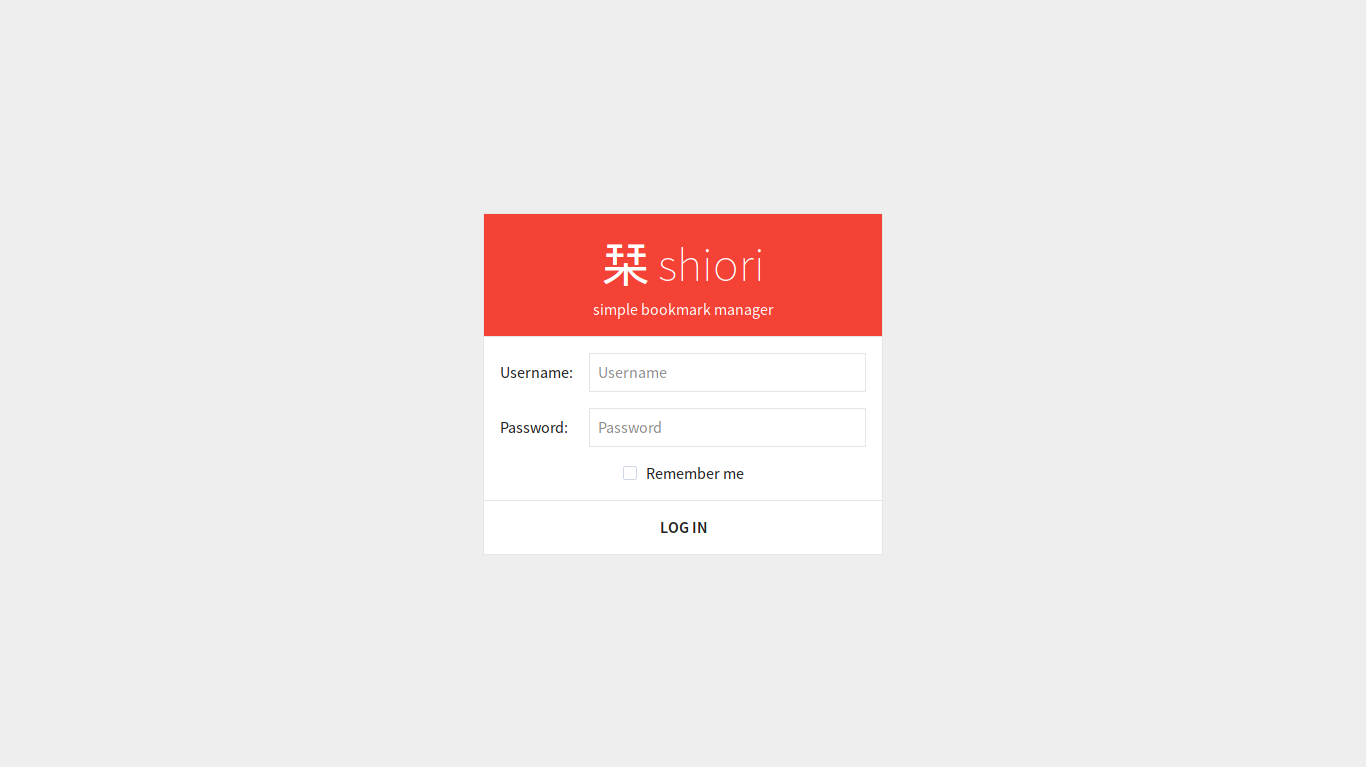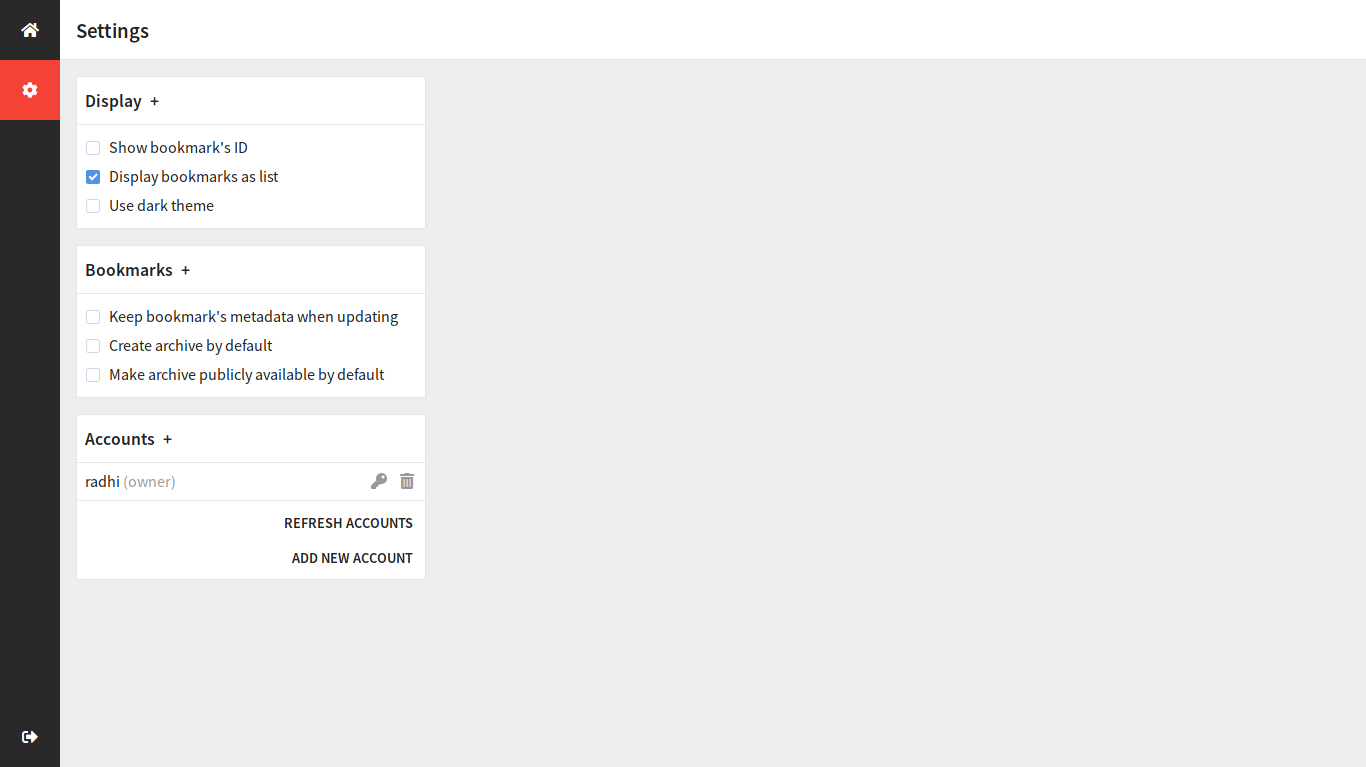-
Notifications
You must be signed in to change notification settings - Fork 574
/
Copy pathUsage.md
192 lines (131 loc) · 8.07 KB
/
Usage.md
1
2
3
4
5
6
7
8
9
10
11
12
13
14
15
16
17
18
19
20
21
22
23
24
25
26
27
28
29
30
31
32
33
34
35
36
37
38
39
40
41
42
43
44
45
46
47
48
49
50
51
52
53
54
55
56
57
58
59
60
61
62
63
64
65
66
67
68
69
70
71
72
73
74
75
76
77
78
79
80
81
82
83
84
85
86
87
88
89
90
91
92
93
94
95
96
97
98
99
100
101
102
103
104
105
106
107
108
109
110
111
112
113
114
115
116
117
118
119
120
121
122
123
124
125
126
127
128
129
130
131
132
133
134
135
136
137
138
139
140
141
142
143
144
145
146
147
148
149
150
151
152
153
154
155
156
157
158
159
160
161
162
163
164
165
166
167
168
169
170
171
172
173
174
175
176
177
178
179
180
181
182
183
184
185
186
187
188
189
190
191
192
Before using `shiori`, make sure it has been installed on your system. By default, `shiori` will store its data in directory `$HOME/.local/share/shiori`. If you want to set the data directory to another location, you can set the environment variable `SHIORI_DIR` (`ENV_SHIORI_DIR` when you are before `1.5.0`) to your desired path.
<!-- TOC -->
- [Running Docker Container](#running-docker-container)
- [Using Command Line Interface](#using-command-line-interface)
- [Search syntax](#search-syntax)
- [Using Web Interface](#using-web-interface)
- [Community contributions](#community-contributions)
- [Improved import from Pocket](#improved-import-from-pocket)
- [Import from Wallabag](#import-from-wallabag)
- [Add URL to Shiori from Android](#Add-URL-to-Shiori-from-Android)
<!-- /TOC -->
## Running Docker Container
> If you are not using `shiori` from Docker image, you can skip this section.
After building or pulling the image, you will be able to start a container from it. To preserve the data, you need to bind the directory for storing database, thumbnails and archive. In this example we're binding the data directory to our current working directory :
```
docker run -d --rm --name shiori -p 8080:8080 -v $(pwd):/shiori ghcr.io/go-shiori/shiori
```
The above command will :
- Creates a new container from image `ghcr.io/go-shiori/shiori`.
- Set the container name to `shiori` (option `--name`).
- Bind the host current working directory to `/shiori` inside container (option `-v`).
- Expose port `8080` in container to port `8080` in host machine (option `-p`).
- Run the container in background (option `-d`).
- Automatically remove the container when it stopped (option `--rm`).
After you've run the container in background, you can access console of the container:
```
docker exec -it shiori sh
```
Now you can use `shiori` like normal. If you've finished, you can stop and remove the container by running :
```
docker stop shiori
```
## Using Command Line Interface
Shiori is composed by several subcommands. To see the documentation, run `shiori -h` :
```
Simple command-line bookmark manager built with Go
Usage:
shiori [command]
Available Commands:
add Bookmark the specified URL
check Find bookmarked sites that no longer exists on the internet
delete Delete the saved bookmarks
export Export bookmarks into HTML file in Netscape Bookmark format
help Help about any command
import Import bookmarks from HTML file in Netscape Bookmark format
open Open the saved bookmarks
pocket Import bookmarks from Pocket's exported HTML file
print Print the saved bookmarks
serve Serve web interface for managing bookmarks
server Run the Shiori webserver [alpha]
update Update the saved bookmarks
version Output the shiori version
Flags:
-h, --help help for shiori
--portable run shiori in portable mode
Use "shiori [command] --help" for more information about a command.
```
### Search syntax
With the `print` command line interface, you can use `-s` flag to submit keywords that will be searched either in url, title, excerpts or cached content.
You may also use `-t` flag to include tags and `-e` flag to exclude tags.
## Using Web Interface
To access web interface run `shiori serve` or start Docker container following tutorial above. If you want to use a different port instead of 8080, you can simply run `shiori serve -p <portnumber>`. Once started you can access the web interface in `http://localhost:8080` or `http://localhost:<portnumber>` if you customized it. You will be greeted with login screen like this :

Since this is our first time, we don't have any account registered yet. With that said, we can use the default user to access web interface :
```
username: shiori
password: gopher
```
Once login succeed you will be able to use the web interface. To add the new account, open the settings page and add accounts as needed :

The first new account you add will become the owner and it will deactivate the "shiori:gopher" default user automatically.
When searching for bookmarks, you may use `tag:tagname` to include tags and `-tag:tagname` to exclude tags in the search bar. You can also use tags dialog to do this :
- `Click` on the tag name to include it;
- `Alt + Click` on the tag name to exclude it.
## Community contributions
### Improved import from Pocket
Shiori offers a [Command Line Interface](https://github.com/go-shiori/shiori/blob/master/docs/Usage.md#using-command-line-interface) with the command `shiori pocket` to import Pocket entries but with this can only import them as links and not as complete entries.
To import your bookmarks from [Pocket](https://getpocket.com/) with the text and images follow these simple steps (based on [Issue 252](https://github.com/go-shiori/shiori/issues/252)):
1. Export your entries from Pocket by visiting https://getpocket.com/export
2. Download [this shell script](https://gist.github.com/fmartingr/88a258bfad47fb00a3ef9d6c38e5699e). [*You need to download this in your docker container or on the device that you are hosting shiori*]. Name it for instance `pocket2shiori.sh`.
> Tip: checkout the documentation for [opening a console in the docker container](https://github.com/go-shiori/shiori/blob/master/docs/Usage.md#running-docker-container).
3. Execute the shell script.
Here are the commands you need to run:
```sh
wget 'https://gist.githubusercontent.com/fmartingr/88a258bfad47fb00a3ef9d6c38e5699e/raw/a21afb20b56d5383b8b975410e0eb538de02b422/pocket2shiori.sh'
chmod +x pocket2shiori.sh
pocket2shiori.sh 'path_to_your/pocket_export.html'
```
> Tip: If you’re using shiori's docker container, ensure that the exported HTML from pocket is accessible inside the docker container.
You should now see `shiori` importing your Pocket entries properly with the text and images.
This is optional, but once the import is complete you can clean up by running:
```sh
rm pocket2shiori.sh 'path_to_your/pocket_export.html'
```
### Import from Wallabag
1. Export your entries from Wallabag as a json file
2. Install [jq](https://stedolan.github.io/jq/download/). You will need this installed before running the script.
3. Download the shell script
[here](https://gist.githubusercontent.com/Aerex/01499c66f6b36a5d997f97ca1b0ab5b1/raw/bf793515540278fc675c7769be74a77ca8a41e62/wallabag2shiori). Similar to the `pocket2shiori.sh` script if you are shiori is in a docker container you will next to run this script
inside the container.
4. Execute the script. Here are the commands that you can run.
```sh
curl -sSOL
https://gist.githubusercontent.com/Aerex/01499c66f6b36a5d997f97ca1b0ab5b1/raw/bf793515540278fc675c7769be74a77ca8a41e62/wallabag2shiori'
chmod +x wallabag2shiori
./wallabag2shiori 'path/to/to/wallabag_export_json_file'
```
### Add URL to Shiori from Android
1. Install [Termux](https://termux.dev/en/)
2. Open termux and run bellow command
```bash
mkdir -p ~/bin
touch ~/bin/termux-url-opener
chmod +x ~/bin/termux-url-opener
nano ~/bin/termux-url-opener
```
3. Edit bellow code and replace `Shiori_URL`, `Username`, `Password` with yours
```bash
#!/bin/bash
# shiori settings
Shiori_URL="http://127.0.0.1:8080"
Username="shiori"
Password="gopher"
token=$(curl -s -X POST -H "Content-Type: application/json" -d '{"username": "'"$Username"'" , "password": "'"$Password"'", "remember": true}' $Shiori_URL/api/v1/auth/login | grep -oP '(?<="token":")[^"]*')
curl -s -X POST -H "Content-Type: application/json" -H "Authorization: Bearer $token" -d '{ "url": "'"$1"'", "createArchive": false, "public": 1, "tags": [], "title": "", "excerpt": "" }' $Shiori_URL/api/bookmarks
exit
```
4. Paste above content in editor and `Volume-down` and `o` than Enter to save file.
5. `Volume-down` and `x` to exit editor.
6. close termux
You can share links with termux from Share menu links will automatically add to Shiori from mobile device.